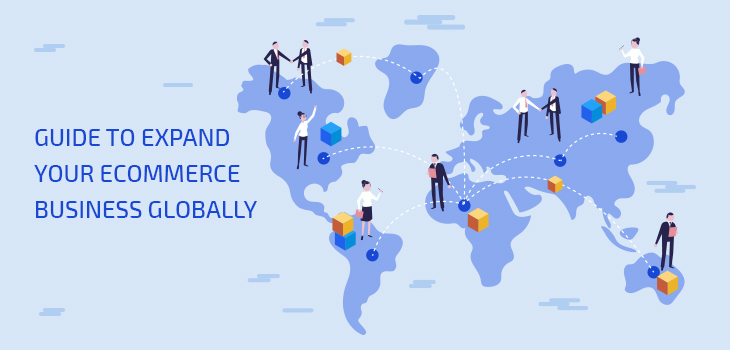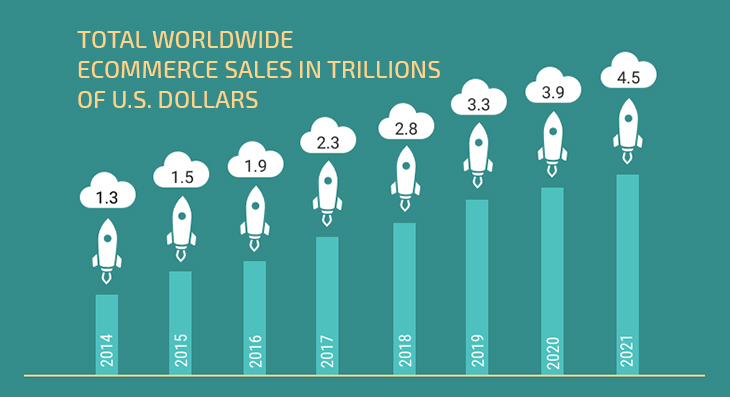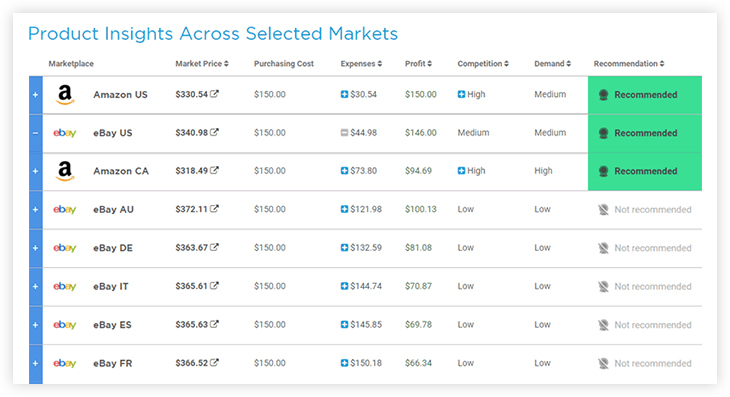
Here’s a staggering figure, according to Forbes in 2017 online retailer Alibaba reported a shocking $25 billion in revenue on Singles’ Day, an antithesis of sorts to Valentine’s Day in which singletons are celebrated with online prices slashed and major discounts offered. To put that number into perspective, Forbes also reports eCommerce sales in the United States for 2017 totalled at $100 million.
Singles’ Day and the combined rise of overseas eCommerce supergiants like Alibaba and Aliexpress, as well as the success of Amazon and eBay in Europe, have many eCommerce sellers turning their eyes toward the shining, lucrative possibilities that lay waiting in the global marketplace.

Image via Shopify The Enterprise Guide to Global Ecommerce
The Enterprise Guide to Global Ecommerce reports that it is predicted that worldwide eCommerce sales will increase from $2.8 trillion in 2018 to $4.5 trillion by 2021. Although technology has all but erased boundaries and borders, there are still some practical and logistical issues that eCommerce sellers may run into when exploring high-growth markets for their products or industry.
Established eCommerce sellers know that a myriad of issues emerges when considering expanding internationally, from cultural differences, operational logistics, sourcing and distribution methods, customs and taxes, and well, the list goes on. Due to the complexities of selling globally, many eCommerce brands are missing out on lucrative opportunities.
Localization matters
To break down the barriers and pave the way for a successful move to selling internationally, sellers must take into consideration the local market. We are currently living in a consumer-driven market, one in which brands and retailers need to create the impression that their customer is known and tailored to, and that the user experience is seamless and enjoyable.
Consumers are more likely to feel comfortable buying a product that is listed in their local currency and includes a thoughtful description in their local language. Try to avoid having your potential customers exit your store site, calculate a currency exchange, and then return and consider buying. Cut the mathematics out of it, and present the information quickly and precisely. Through opening global payment gateways, conversion rates are likely to improve, thus paving the path for more natural customer experience in a new market.
The language also may come into play when you are building your customer service experience. Today consumers rely on reviews as social proof, and this feedback can be what makes or breaks a sale. Consumers expect responses that are near-instant, with clear and helpful information.
Additionally, visitors to your site will feel more confident to follow through on a transaction when navigation, content, and communication are presented in their language. After all, if a consumer receives a response in a language they cannot understand or in very flawed local language, the seller can be view as untrustworthy, and the sale becomes abandoned.

A localized online shopping experience also extends as far as storefront design and marketing efforts. Of course, it won’t be as simple as translating your current content into a different language. Culturally, each company shops differently and expects something different from their online experience. Famously, Starbucks, with over 7,000 locations worldwide, tried bringing its globally recognized brand to Israel, but when it failed to consider specific local requirements, the coffee was giant was instead met with intense backlash.
Israel is the only country in which Starbucks has surrendered, despite difficult entries in other international locations, and its failure is primarily attributed to its lack of sensitivity for local needs and tastes. Indeed, this issue resonates today for eCommerce sellers. Although it was involved with brick and mortar stores, Starbucks is a prime example of how not considering cultural needs and expectations in a different market can take down even the giants among us.
Scalability and end-to-end integration
When expanding internationally, sellers will inevitably run into the issue of managing business processes in real time. The need to seamlessly monitor all the connecting pieces of your business from warehouses to shipping carriers to manufacturers is no easy feat, mainly when you are working across borders. Syncing your information and processes will be hugely influential to the day to day operational success of your eCommerce business.
The need for a seamless transition is also crucial to business processes. Technology seems to be moving faster than most eCommerce businesses can keep up with it, which is both a blessing and a curse. The ability to introduce tools like restricted geolocation will ensure purchases not covered by licensing agreements will not be actionable. This is an obvious help in avoiding unnecessary issues with orders and disappointed customers.
Price, product identifiers, customs, taxes, and other crucial information needs to be organized and controlled across different time zones and in various local languages. Before a seller even enters a new marketplace it is advisable to have actionable data that can be used to identify and expand into new opportunities. A smart product research tool can provide the solution to this critical need by automating the product research process and supplying sellers with crucial insights into product identifiers, weight, product history, marketplace history, and much more- all within minutes.

Image via Algopix
Obtaining accurate eBay or Amazon product research before expanding is crucial to long-term and healthy growth of any eCommerce business. Reducing risk through precise data insights is something any company, no matter its size, can easily accomplish today. Doing so will help gain results in:
- Avoiding unnecessary purchases and thus reducing the cost and risk of overstock or the dreaded slow-moving products through eCommerce market analysis
- Achieving a more comprehensive understanding of opportunities in global marketplaces by gaining access to a more comprehensive understanding of related costs and fees
- Ensuring your supplier is providing fair market rates for products by having access to price quotes from new and or existing suppliers
- Understanding product demand level based on trends and real product sales history
A quality Amazon product research tool or eBay product research tool can give online sellers the competitive advantage above the rest. Identifying which products to buy and where to sell them will dramatically lower risk and increase profits.
Looking ahead to what’s in store for international sellers
Sellers looking to expand or those already present in global markets should turn their attention towards mobile markets. According to Bloomberg, China has over 1 billion smartphone users, and nearly 90% of consumers in China reported making online purchases with their phones. Furthermore, Mckinsey reports that consumers with a tablet will spend 17% more than those using only their smartphone.
With the success China has seen with online selling, including the aforementioned Singles’ Day, western eyes are turning towards Chinese eCommerce practices to learn what can be adopted and made successful on a global scale. Localized apps and curated mobile-friendly stores will undoubtedly be heavy on the minds of international eCommerce sellers in the coming years.
Competitor eCommerce analysis and eCommerce selling tools play a vital role in successfully taking your eCommerce business international. It can certainly feel intimidating expanding an online store, though, with proper product research, remaining sensitive and aware of local needs and differences, and taking into account some critical logistical and integration concerns, there is indeed a tremendous opportunity awaiting seller’s out there.
Whether your business is large or small thanks to automation of product research and the ability to manage and more easily move products across borders, many sellers have a bright future waiting for them in global marketplaces.

Leave a Reply
You must be logged in to post a comment.